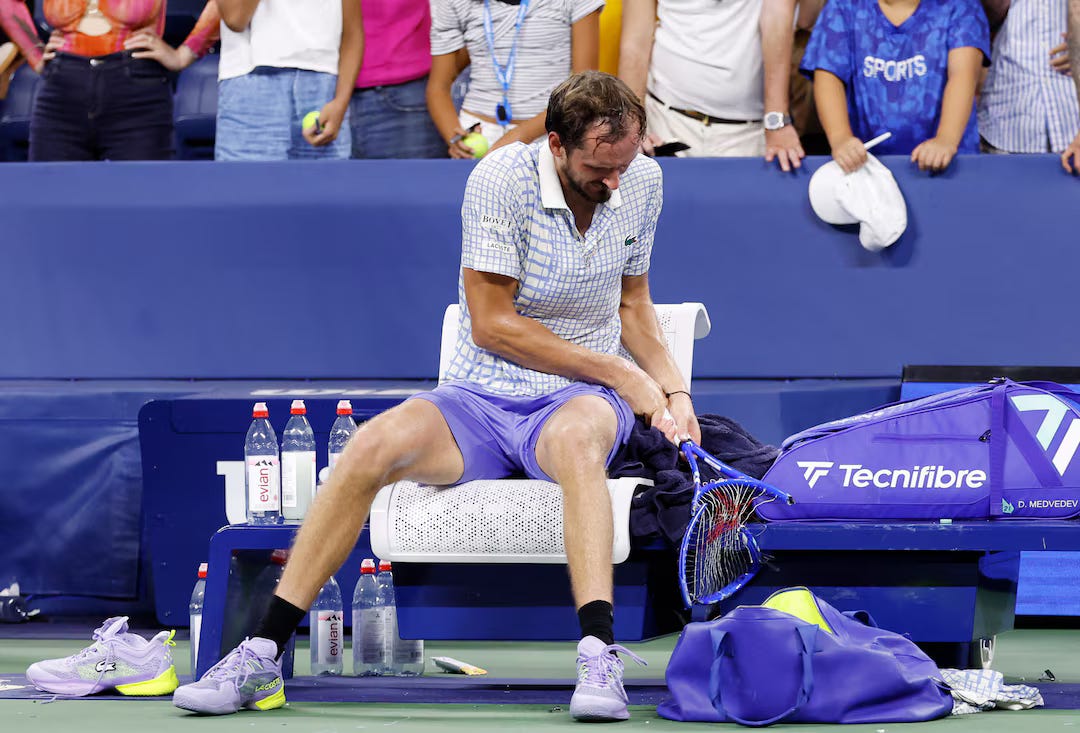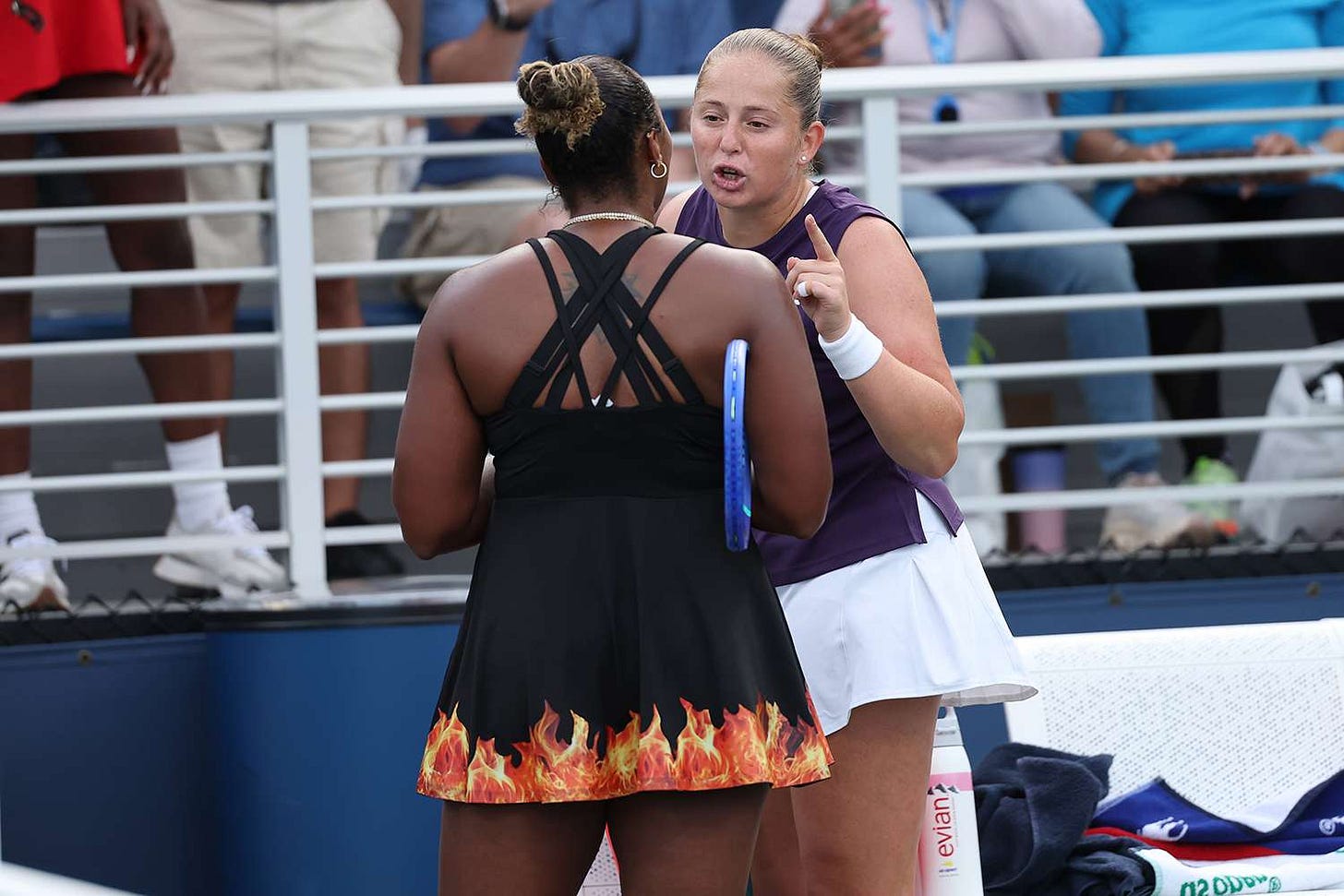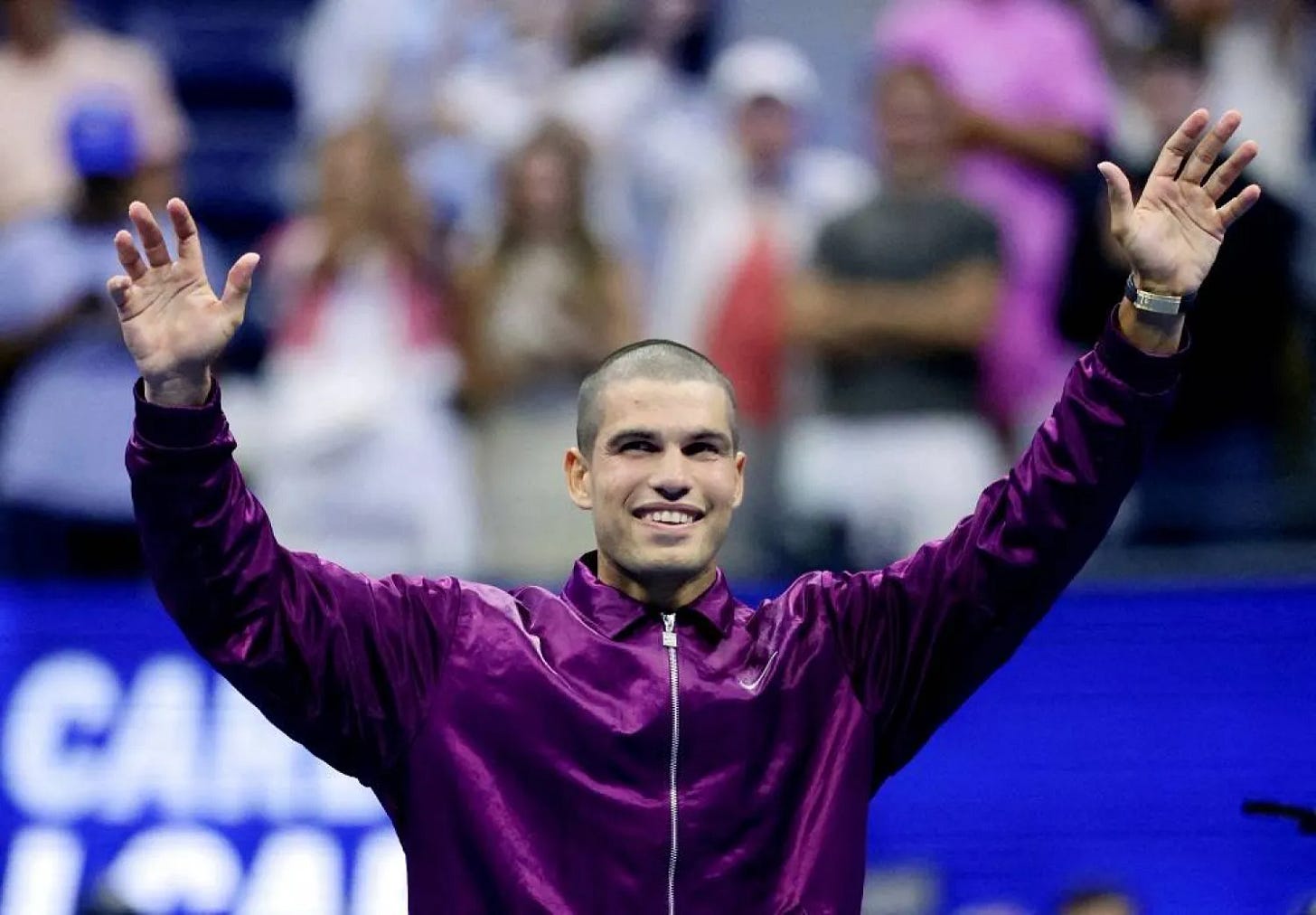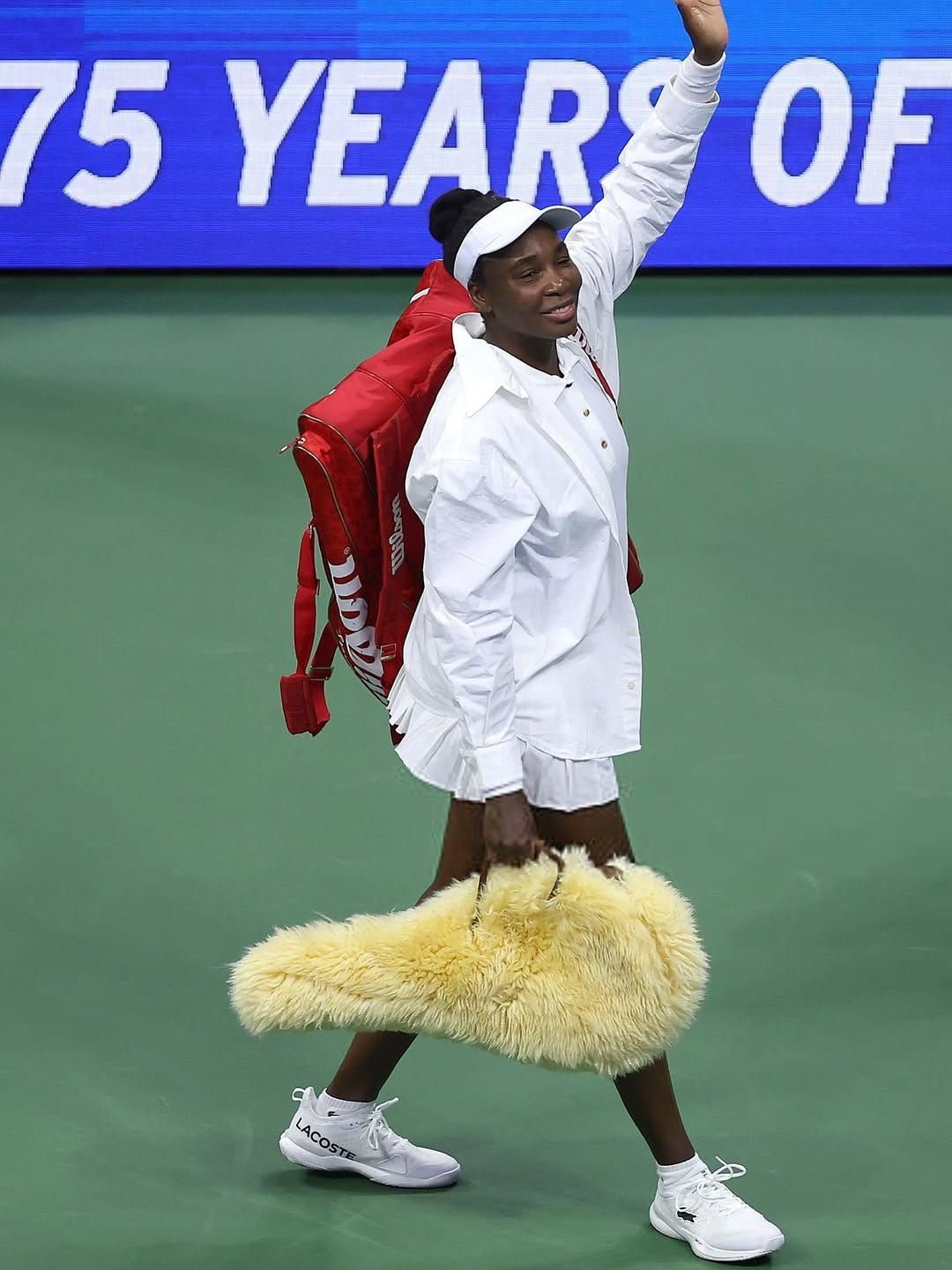Fits, in every sense of the word
The USO brings chaotic meltdowns, raucous crowds, and racism. Plus, former Nike athletes weigh in on what drove their exits and Venus wins the kit-off.
The Replay
Crowds and players lose control
In the span of what felt like both 30 years and three seconds, the first round of the US Open has come and gone, and we’ve already entered a chaotic second round. Barring world No. 6 Madison Keys’ R1 exit, the players you’d expect to win have won (we did it, Joe), but two results that fall in slightly different places on the upset spectrum left a lasting impression. A good or bad impression? Answers may will vary.
First there was Clara Tauson (14) vs. Alexandra Eala (75), the 20-year-old Filipino phenom you’d have to be heartless not to root for. With a set each, Eala fought back from a 5-1 deficit in the third, with a pivotal video review at 5-4 while Tauson was serving for the match shifting the momentum. The crowd, influenced in part by New York’s large Filipino population, had already been Team Eala for the whole match, but after Tauson complained about a shot Eala made near the net that she felt had crossed over the tape (which the umpire reviewed and awarded her the point for), the fans turned ugly. They booed her for arguing with the umpire over the call (ok, that’s a classic), but then they booed her double faults (a bit much, IMO). I had snuck into a perch high atop Grandstand in the hopes of seeing Eala win, but I couldn’t help but feel bad for Tauson. Tennis often takes itself too seriously, but I do prefer its general etiquette to the no-holds-barred fan behavior of other sports. I’m not much of a traditionalist, but I am a big ol’ softie who’s a little allergic to mean-spirited ruckus.
Of course, nothing about this match, which ended with a goosebump-worthy tiebreaker that Eala ultimately won to massive applause, flew as close to the sun as what we saw later that night from one Daniil Medvedev (13) and his (because it was his) crowd in his first round match against Benjamin Bonzi (51). You’ve all likely heard the story by now, and if you haven’t, you can check it out here, but the whole ordeal gave me pause. I’ve always been a Meddy chaos appreciator—I mean, the dude is undeniably entertaining—but his meltdowns have been rising in intensity over the last few months, and this one felt like a climax. Judging from the sentiments on social media and the hefty $42.5k fine he received from the tournament, I’m not alone. Boris Becker wondered on Twitter if he needed professional help, and Andrey Rublev (who’s struggled but worked hard to overcome a different stripe of self-inflicted meltdowns on court) told the press that if Medvedev wanted his help, he’d be there. Fans have often lamented that Medvedev gets away with more shenanigans than other players (particularly women and people of color), and I think we may have finally reached the-jig-is-up territory with him. It’s no longer cute or funny; it’s largely disturbing and sad. I’ll be curious to see where he goes from here, but I think a break is sorely needed.
Unstrung
Ostapenko brings racism on court
I was originally going to award this section to Meddy, but Jelena Ostapenko (26) decided to volunteer herself by being undeniably racist towards Taylor Townsend (139) after losing to her in their second round match last night. Many journalists will dance around the obvious here, because whatever performative reading of anti-racism books was done in 2020 didn’t really stick, and suddenly the R word is scary again, but yeah—that was some seriously racist shit.
As Townsend and Ostapenko met at the net to shake hands, Ostapenko got in Townsend’s face, pointed finger and all, about how disrespectful it was of Townsend to not apologize for a point she won off a net cord. Sure, it is common practice for opponents to apologize for these points, and I have seen other players get upset when it’s not done, but never to this level. In the words of one Ben Shelton, “So soft, so soft.”
Ostapenko’s energy towards Townsend reeked of entitlement, and, despite being known on tour for throwing fits, her level of anger seemed ultra-aggressive this time. It made me uncomfortable from the jump, and my initial hmm-this-seems-fueled-by-racism hunch was only confirmed when Townsend later told press that Ostapenko told her “she had no class, no education, and to see what happens when I got outside the U.S.” Those are loaded, derogatory words and ones that Ostapenko has never uttered to any of the white women she’s beefed with on tour. So yeah, I think we can call a spade a (racist) spade.
Props to Townsend for handling it well, and this perfect mic drop moment.
Kitted
Athletes weigh in on the Nike exodus
I wanted to give Nike some credit; their US Open kit for Carlos Alcaraz—a deep magenta tank top and shorts, complete with a shimmery walk-on jacket—is a step up from tournaments past. Although I think Carlos’s edgy new hairless cut, which is so bad it’s actually good, did some of the heavy lifting. But then they put his rival Jannik Sinner in essentially the same kit in burnt orange, just with a polo shirt instead. These men are not only two of the most famous athletes in the world, but they also could not be more different, so how do you not invest a little extra time and money into creating truly different kits that underscore their worlds-apart personalities and act as a visual display of their epic rivalry?
I will never understand, and the women’s kits have been similarly frustrating, including a not-exactly-groundbreaking cut-out dress for world No. 1 Aryna Sabalenka or the drab blue dress that Madison Keys (unfortunately) lost in. Somehow, though, Naomi Osaka is getting good looks out of them—is she simply more marketable, more invested and involved in the design process, or both? If you have the scoop, let me know.
In press conferences leading up to the US Open, players who have left Nike in the past few years opened up about what drove their decisions, confirming many of my earlier suspicions. Money is a huge factor, of course, but they all echoed the appeal of working with a brand that could devote most of its (tennis) resources to them and them alone.
For Jack Draper, it was his contract coming up for renewal this summer that gave him the push to look around. “Vuori came in with an opportunity I couldn’t turn down,” he said, one that journalist Jon Wertheim has said he heard was worth more than Draper’s total prize money ($8.1 million) alone. Draper also talked about wanting to stand out more and, as I expected, not see the same kit across the net, hinting that the Vuori team was more creative than what he experienced at the Swoosh. “Their creative mindset and their values really align well with what I want to do,” he said. “The kits we’re going to create together are going to be very cool.” People are divided over this, but I do think they’re a big upgrade.
Taylor Fritz underscored that the top tennis brands these days “zero in” on a couple of top players, like the Alcarazes, Sinners, and Sabalenkas. That can make it hard for other players, even those like Fritz, Draper, and Keys who are also in the top 10, to stand out. “There are a lot more options for players [today],” he said, noting the rise in tennis interest from non-category brands.
Frances Tiafoe, our candid king, put it more bluntly: “There was a lot of interest for me in the market, and more than Nike had.” Being the central face of a brand was especially appealing to both him and Draper. “I can build and grow with them, and they can brand me at the highest level,” said Tiafoe. “I said Why don’t I do something different and be the guy rather than one of [the guys]?”
It will be interesting to see who, if anyone, jumps ship next—I would love to see some of the WTA players spice it up too, a la Gauff and New Balance x Miu Miu.
Venus lost early, but won the kit-off
It’s always a good day when we get to watch Venus Williams play tennis. Although she lost in the first round of the US Open to Karolina Muchova (13), she left a lasting impression not just with that beautiful second set but with both of her kits.
In partnership with her stylist, Ronald Burton III, Williams collaborated with cool(est) girl luxury brand Khaite on a dress and visor for her mixed doubles match with Reilly Opelka. The navy tennis dress was classic with a twist, featuring white lining, a square neckline, cap sleeves, and a cut-out in the back to show off the sports bra underneath with the Khaite logo.
For her first round singles match, she partnered with the hip California brand ERL on a white polo and pleated skirt set inspired by Althea Gibson, one of the first Black players to cross the color line of international tennis 75 years ago, and who the US Open is honoring this year. The inspiration alone made it interesting, but it was also topped off with a quirky accessory: a seriously fuzzy yellow shearling racquet bag.
Now that Williams has paired up with Leylah Fernandez to play doubles, I’m hoping we’ll get to see what other custom kits the duo might have in store for us.
Hot Takes
Tiafoe and Gauff weigh in on the increasingly repetitive Sinner-Alcaraz rivalry
When the Cincinnati final wound up being another rematch between Sinner and Alcaraz, I confess I was not thrilled. I love them both as players, and they’ve given us some epic battles, but watching the same duo over and over again loses its appeal quickly. The uncertainty of who might take Toronto, which they both sat out, was a nice reprieve from the same old same old.
It turns out that I’m not alone. In a press conference ahead of the US Open, Frances Tiafoe seemed to pull his thoughts straight from my brain, saying, “To be honest with you, I’m not even tapping in anymore, it’s too much. It’s like, alright, I get it, we need something new.” He was quick to shout them each out and say he loved them both (a prerequisite for any remotely negative comment about the rivalry if you’re familiar with their fanbases), but said, in perhaps a bit of wishful thinking, “They’re gonna get interrupted, I can’t see them playing the finals every week.” The question we’re all still wondering, though, is by who?
Coco Gauff echoed his sentiments, highlighting the beauty of the unpredictability of the WTA in the process. “When you go into the tournament and you know already who’s going to make the final or at least the semis, it can be a little bit boring,” she said. “Obviously, Carlos and Jannik are always entertaining to watch, but it’s cool when there’s a possibility of a new champion.” She made a good point that women playing best-of-three sets means there’s more probability for new winners, whereas best-of-five tends to favor the better or more experienced player, as they have more time to play into form and can often endure over a longer period.
Off-Court
A quick round-up of other key happenings
Jack Draper withdrew from the US Open ahead of the second round, citing his lingering arm injury (a bruise on his humerus bone). It’s a huge bummer for the Brit who hasn’t played more than a few competitive matches since Wimbledon and raises questions about when he’ll be able to return. This tweet did, however, give me a chuckle.
You heard it here first, and it was true! Jessica Pegula launched a podcast this week called The Players Box alongside Madison Keys, Jennifer Brady, and Desirae Krawczyk. In their own words, it will bring listeners into “life on the road, being athletes, women, and our daily conversations,” with the first episode out now. Nothing Major officially has some WTA competition. I’ll weigh in once I finally get a chance to listen.
It’s been a big week for tennis players in magazines. Aryna Sabalenka stars on the cover of Boardroom (co-founded by Kevin Durant and Rich Kleiman); Alexandra Eala fronts the digital cover of Town & Country; the ATP’s pretty boy Lorenzo Musetti is in Vogue; and Anna Kalinskaya is in the indie Flaunt Magazine.
The ATP Tour is launching its first fashion marketing program, as I covered for Vogue Business. Following in the footsteps of the NBA and NFL, the goal is to brand its players as sartorial stars. You can read it here behind a paywall (or, if you sign up for a paid subscription to Hard Court and DM/email me, I’ll send you a PDF of this and any future paywalled stories). My tennis friends were quick to heavy sigh the fact that women’s tennis isn’t doing something similar. What say you, WTA?
Thanks for reading! If you have tennis news or tips to share, email jessica@hard-court.com.







Ugh I’ve defended Ostapenko’s shenanigans for years, but this was terrible and obviously racist. I thought it was cowardly for Andy Roddick to completely ignore that aspect of the story on his pod.
well synthesized!!!! waiting patiently for *the right* designers to infiltrate tennis and bring something actually-good and actually-new to player outfits <3